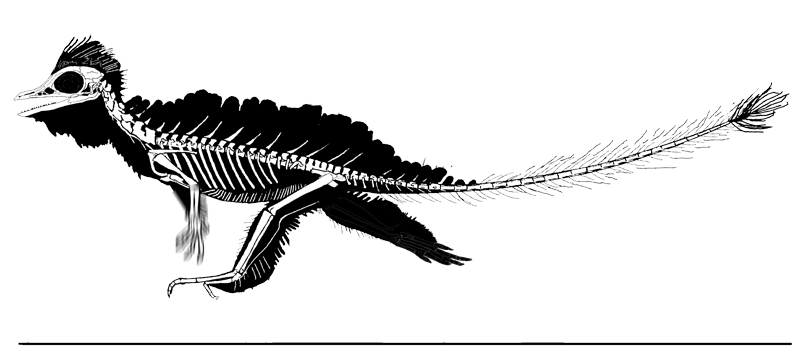Everyone agrees
all pterosaurs had extradermal structures such as these, even when not preserved (Fig 1): wing membranes, propatagia, uropatagia and sometimes soft crests atop the skull opposite the gular sac at the throat.

Everyone also agrees
all pterosaurs had dermal membranes: Skin, of course, but also pycnofibers, small feathery structures arising from the neck, torso and limbs suitable for a warm-blooded, largely active metabolism. These feathery fibers are preserved on relatively few specimens (Figs 2, 3).

Not everyone agrees on the origin of those feathery structures.
Benton and his followers hope pterosaur feathery structures are homologous with dinosaur feathers. They do this without phylogenetic analysis and their decades long practice of taxon esclusion. This is how myths spread.


Benton omits the fact that when tested with lepidosaurs,
pterosaurs nest with lepidosaurs (Peters 2000, 2007), far from dinosaurs. Benton 1985 recovered pterosaurs with lepidosaurs. Thereafter Benton explicitly avoided testing lepidosaurs as competing candidates. In Hone and Benton 2007 the authors promised to test taxa from Peters 2000 vs taxa from Bennett 1996, then Hone and Benton 2009 omitted these taxa, omitted Peters 2000 and falsely gave Bennett 1996 the credit for both sides of the argument. Yes, things like this happen in paleontology when you peek behind the curtain.
Getting back to the subject at hand,
Cosesaurus, Sharovipteryx and Longsiquama all preserve feathery structures nearly identical to those found in pterosaurs. These are overlooked by Benton and his followers. Moreover the fossil bones of these three also link them to pterosaurs better than any of the other 2162+ taxa currently tested in the large reptile tree (LRT, 2159 taxa).
Not everyone agrees on the extent
of the extradermal membranes. Elgin, Hone and Frey 2011 stooped to extending all the membranes beyond their actual extent (Fig 1) claiming ‘shrinkage’ whenever they encountered evidence of a shallow chord (= every specimen). A shallow chord was first reported by Zittel, 1882 and then Peters 2002.

More controversial than wing shape
is the presence of a parasagittal series of dorsal plumes in pterosaurs, like those widely recognized in Longisquama and identified in Cosesaurus (Fig 6) and Jeholopterus (Figs 3, 4).
Finally let’s take a look at Ctenochasma elegans
(Figs 8–11). That’s the Royal Ontario Museum’s specimen from the Solnhofen Formation.

When pterosaurs fold their wings
the membranes fold away, nearly to invisibility (Fig 10) as demonstrated by fossils like Ctenochasma. Most artists don’t get this. As in all pterosaurs, the chord is short, not extending down to the ankle. Sadly this is what Elgin, Hone and Frey (Fig 7) described as ‘shrinkage’. This is real. This is how birds are built, by convergence. This enables wing folding without membrane drooping. This enables the wings to flap independent of the hind limbs. This enables bipedal locomotion, take-off and landing. That beachcombing pterosaurs made quadrupedal tracks is just what they do. That’s a reversal. We have bipedal pterosaur tracks for other trackmakers.

Pterosaurs are lepidosaurs based on a long list of traits.
including a long finger four and a long toe five (in basal pterosaurs). Those splayed hind limbs (Fig 11) are typical of lepidosaurs. In flight the soles of the feet faced each other as if the pterosaur were an airplane with twin rudders. The uropatagia acted like horizontal stabilizers especially when those aerodynamic hind legs extended laterally.

Like pre-bird dinosaurs,
pre-pterosaur fenestrasaurs, like Cosesaurus, flapped without flying. That tells us pterosaurs became volant after flapping, after developing various extradermal membranes, all as secondary sexual characteristics (= ways to entice a mate, Peters 2002). Fenestrasaurs, like Middle Triassic Cosesaurus, radiated during the Late Triassic. Only pterosaurs became volant, while speedy and showy Sharoviperyx and Longisquama did not, analogous to the many non-volant near-bird dinosaurs that developed feathers by convergence.
References
Elgin RA, Hone DWE and Frey E 2011. The extent of the pterosaur flight membrane. Acta Palaeontologica Polonica 56 (1), 2011: 99-111. doi: 10.4202/app.2009.0145
Peters D 1995. Wing shape in pterosaurs. Nature 374, 315-316.
Peters D 2002. A New Model for the Evolution of the Pterosaur Wing – with a twist. – Historical Biology 15: 277–301.
Peters D 2009. A reinterpretation of pteroid articulation in pterosaurs. Journal of Vertebrate Paleontology 29:1327-1330.
Sharov AG 1971. New flying reptiles fro the Mesozoic of Kazakhstan and Kirghizia. Trudy of the Paleontological Institute, Akademia Nauk, USSR, Moscow, 130: 104–113 [in Russian].
Unwin DM and Bakhurina NN 1994. Sordes pilosus and the nature of the pterosaur flight apparatus. Nature 371: 62-64.
Zittel KA 1882. Über Flugsaurier aus dem lithographischen Schiefer Bayerns. Palaeontographica 29: 7-80.
ReptileEvolution.com/pterosaur-wings.htm




